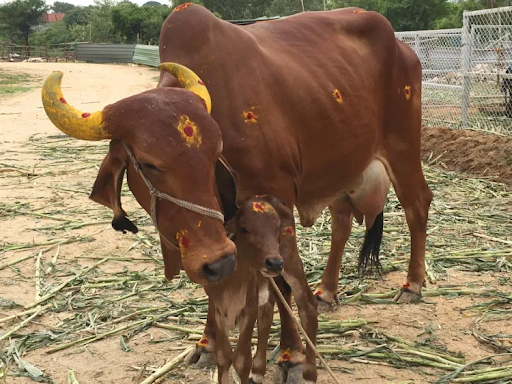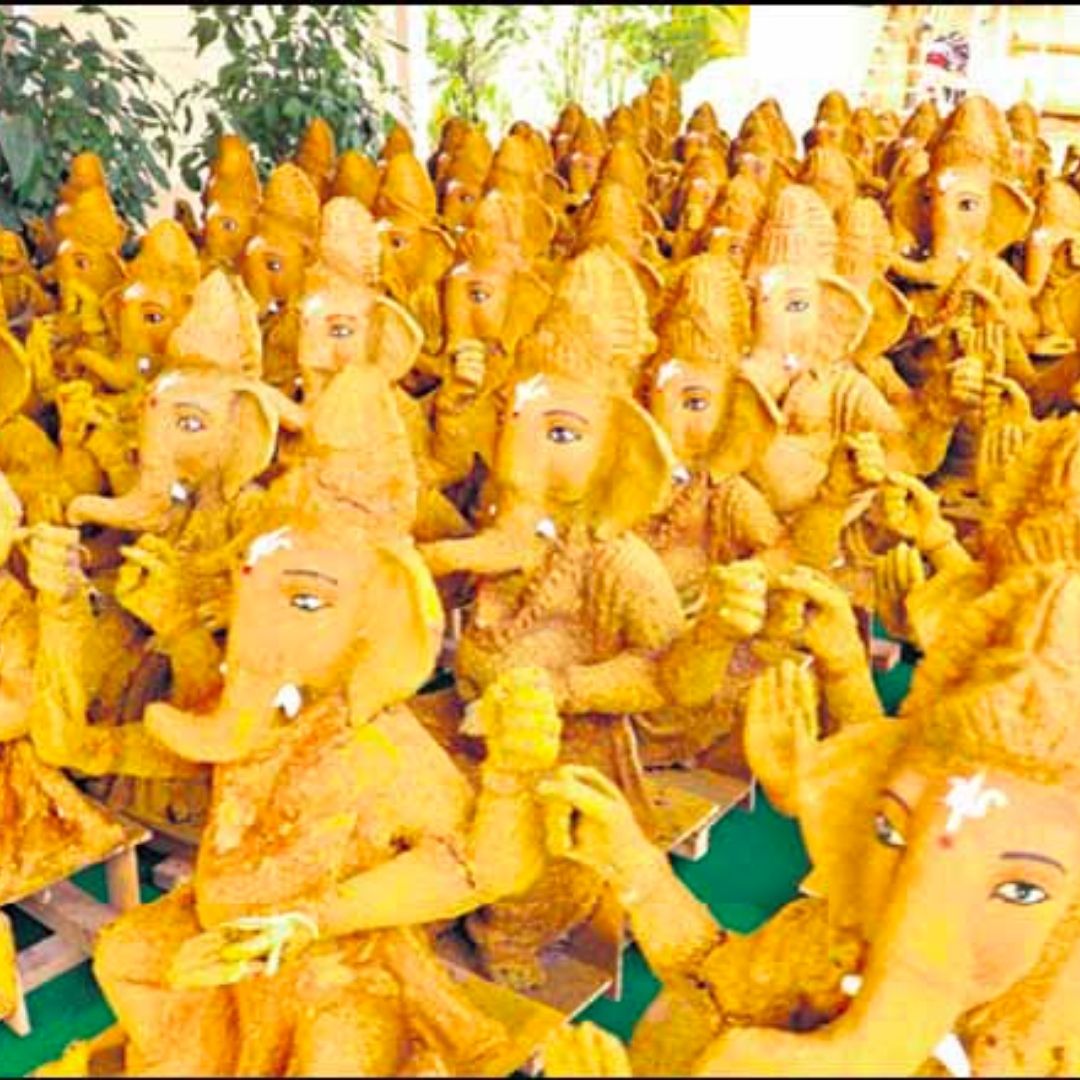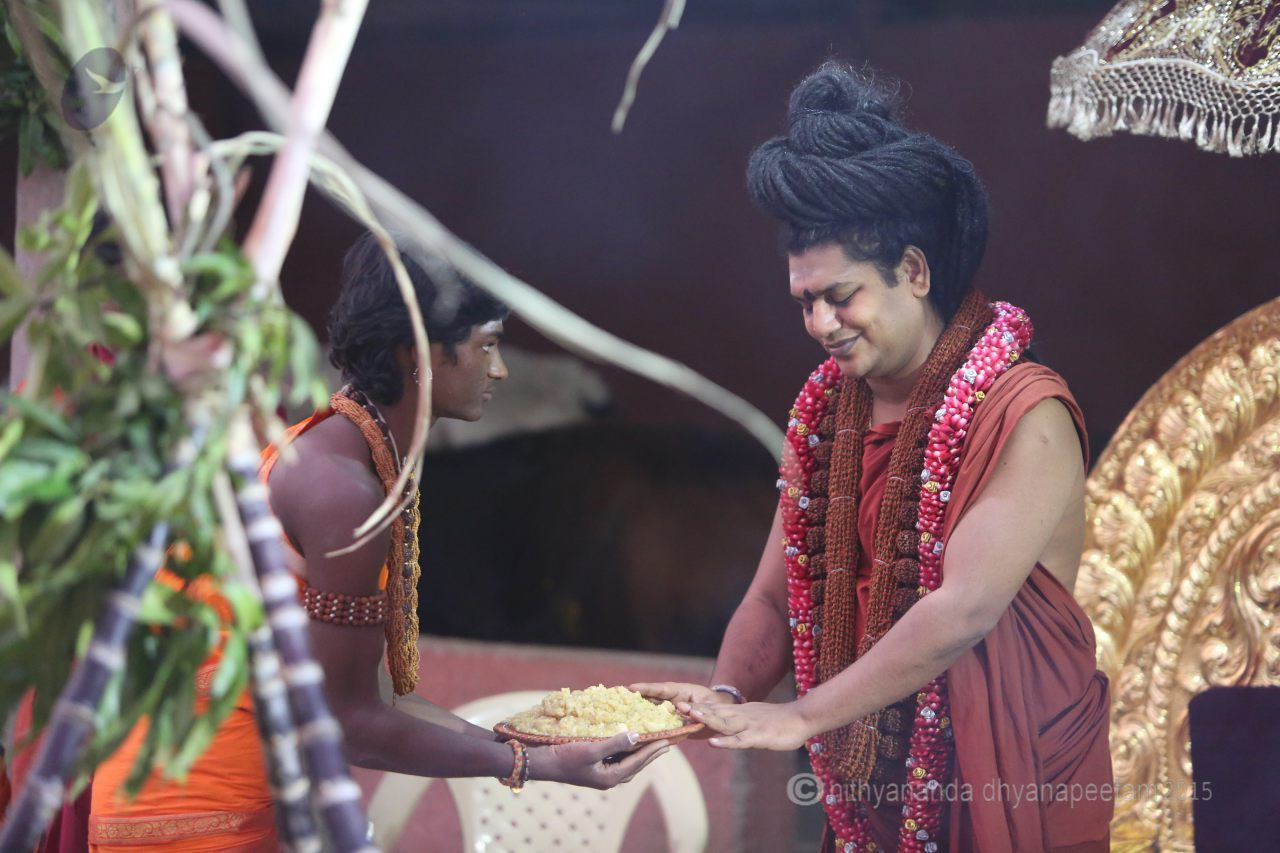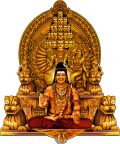
Index
SPH on Gomata
Gomata in Vedic Tradition
Kamadhenu – Gift from Samudra Manthan
Panchagavya – By-products that Nourish and Heal
Gomata – By-products in Ayurveda & Fire Rituals
The Humble Gomutra
Precious Gomaya
Honoured in Hinduism
Gau Puja @ Aadi Kailaasa, Bidadi, Bengaluru Aadheenam
Goshala – Home for Gomata
Gomata – A Many Faceted Resource
Sadashivoham December 2016 – Preparations
Go Goshala in Aadi Kailaasa
India – Home to Best Cattle Breeds in the World
Hinduism is the greater science of the universe, life. Aligning our principles of our life to that of Hinduism, directly raises our level of consciousness, health and wellbeing. In all the Vedagamic traditions, only three things are universally recognized as sacred: Om, the Cow and practicing a morning spiritual routine.
But why is this important to you? Because you imbibe much more than just calcium from the glass of milk you drink everyday. Gomata, the cow who feeds you, is literally like your mother. How she feels, directly affects you. In a global seminar while addressing the need for vegetarian diet as a necessity to experience higher truths of the universe, SPH clarifies..
“Understand. Here when I say Shaivite, not only vegetarian, using the pure cow ghee. The cow which is worshipped and revered cow, not abused, tortured, caged. No. Worshipped, revered cow’s ghee. Where happy cow, where animals are happy. They don’t see their elders being killed because they don’t give milk anymore. In our goshala, the first rule is no question of killing whether an animal is productive or unproductive, and not only no question of killing, no question of … any disrespect, any abuse.
Not only they are … kept lovingly, happily, they are worshipped, revered. Every day Go Puja happens. They know they are respected, they are revered, they are worshipped. Worshipped cow’s ghee. Listen carefully. When a cow is respected and worshipped, … its blood is churned with emotion called bliss and joy. So that milk carries that bio memory of joy and bliss, understand. Cow is a animal which can … feel the emotions intensely as intensely as human beings, and transmit that emotion into its blood, and the whole being. Listen carefully, how your emotions directly affect the quality of your blood, cow’s emotions directly affect the quality of cow’s blood and in turn cow’s milk. Happy cow’s ghee awakens your whole brain.”
Ref : Nithyananda Satsang, Oct 11 2019 , https://nithyanandapedia.org/wiki/October_11_2019
SPH enlightens us on how creating non violent, compassion based goshalas where cows are worshipped and revered can transform the world at a global level. In His own words, SPH says,
“If we can produce pure compassionate bio-memories beings on the planet Earth we can bring more bliss and security and safety to planet earth.
Making pure compassion bio-memory in the kids and cows is very easy because by nature if you love kids and cows they also become compassionate they make you also compassionate.
Having one blissful cow which is 100% loved and cared radiates pure compassion muscle memory equivalent to one enlightened being.
That’s why I am focusing and putting so much energy into build loving, caring, compassionate goshalas and blissful cow mandirs.
All the cows in our goshalas and kids in our gurukul are evolving as pure compassion bio memories.
Once they evolve as pure compassion muscle memories they will be ready to get great enlightenment sciences and powers downloaded into them.
This is the greatest productive work we can do to revive enlightenment eco-systems on the planet earth.
If you just make pure compassion goshalas for 1000 cows and make blissful cows it will be equivalent to having 1000 enlightened beings.
Ref: Nithyananda Satsang- August 8 2019, https://nithyanandapedia.org/wiki/August_08_2019
It has also been reveled since time immemorial in the Hindu Shastras
BHAGWAN SRI KRISHNA DECLARES BEAUTIFULLY
गावो ममाग्रतो नित्यं गावः पृष्ठत एव च । गावो मे सर्वतश्चैव गवां मध्ये वसाह्यहम् ॥
(MAHABHARATA, ANUSHASANA PARVA 80-3) LET THERE BE COWS IN FRONT OF ME, BEHIND ME AND ALL AROUND ME. I LIVE WITH THE COWS.
PADMAPURANA ALSO REVEALS
गावो बंधुर्मनुष्याणां मनुष्याबांधवा गवाम् । गौः यस्मिन् गृहेनास्ति तद्बंधुरहितं गृहम् ॥
COWS ARE THE ABODE OF THE GODDESS OF WEALTH. SINS DON’T TOUCH THEM. THERE EXISTS A FINE RELATIONSHIP BETWEEN MAN AND COW. A HOME WITHOUT A COW IS LIKE ONE WITHOUT DEAR ONES.
दानानामपि सर्वेषां गवां दानं प्रशस्यते ।
गावः श्रेष्ठाः पवित्राश्च पावनं ह्येतदुत्तमम् ॥
(MAHABHARATA, ANUSHASANA PARVA 83-3) DONATION OF COWS IS SUPERIOR TO ALL OTHERS. COWS ARE SUPREME AND SACRED.
It is thus that SPH takes deep interest in reviving the right ecosystems to take care of cows and announced that He is establishing the Nandi Sarvajnapeetam, and that this NSJP will revive the entire tradition of Gomatha worship and Goseva as per the Vedagamic Traditions. (Ref:https://nithyanandapedia.org/wiki/June_24_2019_)
On 26 June 2019, SPH announced,
“According to sanatana hinduism – cow is the embodiment of all gods and goddesses. by living and serving the cows, one attains the punya ( good karma ) of serving all the gods and goddesses.
The nandi sarvajnapeetam is going to open in various kailaasa all around the world .
understand, just living with the cows, touching them and serving them , all your violence, anger etc just melts down. you will become a compassionate and loving being.
I can see clearly our goshalas are going to be enriching the world with huge quantity and quality of satvik food organic dairy products,best cow urine based medicines for health,goseva as path for enlightenment.
Best enlightenment and life sustenance eco system is getting created for the whole world”
Ref: Nithyananda Satsang , June 26 2019, https://nithyanandapedia.org/wiki/June_26_2019

Gomata with her calf – Aadi Kailaasa, Bidadi Aadheenam, Bengaluru – January 16, 2016
In Vedic tradition, gau or dhenu, i.e. cow, is the loving mother of beings and is Bhudevi, Mother Earth incarnate. Hindu scriptures extol the divine Kamadhenu, the wish fulfilling cow goddess, and all earthly cows on planet earth are earthly embodiments of her. Cows are the refuge of all-auspiciousness, strength, abundance which bestow happiness, nourishment and prosperity. In Vedic India every home and hermitage had the loving presence of cows and gifting cows to brahmanas was considered the ultimate offering of wealth that brought huge punya to the giver.
She is mentioned in Rig Veda (4.28.1;6), as:
“The cows have come and have brought us good fortune. In our stalls, contented, may they stay! May they bring forth calves for us, many-colored, giving milk for Indra each day. You make, O cows, the thin man sleek; to the unlovely you bring beauty. Rejoice our homestead with pleasant lowing. In our assemblies we laud your vigor.”
The Rig Veda defines and echoes the sentiment of Sanatana Hindu Dharma toward the cow. To the Hindu, the cow is a figurative and literal maternal provider held in the highest of esteem. A being of gentle disposition, she embodies the pure Sanatana Hindu Dharma dogma of ahimsa or non-violence.
Kamadhenu – The gift of Samudra Mathan

In the pastoral economy of the Vedic times, the cow was seen as the cosmic provider and the provider of plenty. Kamadhenu was the mother of all cattle. She is the miraculous cow of plenty, who provides her owner whatever he desires. She emerged as one of the 14 gifts from the Samudra Manthan (Churning of the Milky Ocean) and was given as a gift to the Saptarishis (7 great sages). She was ordered by Brahma the Creator to give milk, and supply milk and ghee or clarified butter, for ritual and fire-sacrifices.
As in many concepts in Hinduism, the cow is a pure being embodying the virtues to which we aspire. She is a symbol of grace, virtue and abundance who takes undiluted Earth in the form of grass and water then bestows milk with no expectation. Similarly, an enlightened being gives of his or her spiritual knowledge with pure abandon without notion of reciprocation. The sacred cow carries the qualities that Hindus espouse and aspire to, those of virtue, maternity and above all, selfless service to others.
Panchagavya – By-products that Nourish and Heal

Cows are fruit of all Vedic ceremonies as all sacred rituals are dependent on its 5 gifts or panchagavya – i.e. ghee, gomutra or cow urine, gomaya or cow dung, milk, curds for its rituals. It is customary in Vedic homes and temples to coat the floor with gomaya to purify the environment before inviting divine energies.
Milk and ghee are staples of Hindu religious rituals and observances. Her core strength tills the fields while dung fertilizes the earth and is used as fuel in village homes. Though not directly worshipped these days, other than at certain specific rituals such as Govardhan puja, the cow is often decorated with jewelry, paint, and garlanded for various Hindu festivals. Hindu rites celebrate and honor the cow by using her fruits in ceremonial purposes.
Gomata – By-products in Ayurveda & Fire Rituals
Ayurveda understands that some physical and emotional health crisis cannot be healed with diet and herbs alone. They need the deeper and subtler healing yagnas/homas to clear astrological past karmas. Gaumata offers its bounty by providing the ingredients for the panchamrit or sacred ambrosia that is distributed after the ceremony. Panchamrit is made of 5 items – milk, yoghurt, ghee, honey and jaggery.
Ayurveda is a big proponent of the sattvic qualities of milk and dairy products. This is why many Hindus are vegetarians, and do not find the need to become vegan, a movement receiving huge momentum in the West. Fresh organic milk, yoghurt (curds), buttermilk, paneer (cottage cheese) and ghee are all considered highly nutritious, provide important nutrients such as protein, calcium, etc. giving the body strength and immunity. They therefore form an important part of the daily diet of Indian vegetarian food.
The Humble Gomutra

There are 18 nutrients that earth and body require to be healthy. The only by-product in the world to contain all these 18 nutrients is the humble cow’s urine or gomutra.
Gomutra is used in certain rituals of Hindu traditions. It is also an important therapeutic remedy in the Vedic system of medicine, Ayurveda and a product of purification in Vastu Shastra. Now, the gomutra is also gaining popularity as a cleansing and sanitising agent for hospitals and homes.
The Precious Gomaya
Cow dung or gomaya is saved and used as fuel, as it is high in methane and can generate heat and electricity. Many village homes are plastered with a mud/cow dung mixture, which insulates the walls and floors from extreme hot and cold temperatures. Cow dung is also rich in minerals, and makes an excellent fertilizer. There is now an increasing interest in the organic farming movement in India and to return to ancient methods utilizing cow dung to re-mineralize the depleted soil.
Vibhuti, the most cherished body embellishment of the Saivites of every Saivite sampradaya, is made from this incredible by-product of Gomata.
Now gomaya use has expanded its repertoire to include a wide-ranging products such as agarbatti, sambrani, flower pots, Diwali deepas, soaps, Ganesha idols, logs for cremation, bricks for construction. With the current Prime Minister’s stress on Atma Nirbhar Bharat, a whole host of young entrepreneurs are coming up with several new ideas and uses for this humble “waste”.

Gomaya Ganesha

Sambrani

Dhoop Sticks

Vibhuti
Honoured in Hinduism


Sri Krishna doing Gau Puja
Honouring the cow bestows glory not only to living creatures but honours the Earth and our Earthly ecosystems. In Hinduism the cow is given respect and honoured as a divine cosmic mother; which is why cow slaughter is blasphemous for a staunch Hindu. The practice of not eating beef not only has numerous health benefits but is also beneficial to our ecosystem and economy. Hinduism is a faith of connection with nature and, through the cow, Hindus learn the virtues of gentleness and return to natural order.
“Hindus regard all living creatures as sacred – mammals, fishes, birds and more. We acknowledge this reverence for life in our special affection for the cow. At festivals we decorate and honour her. To the Hindu, the cow symbolizes all other creatures. The cow is a symbol of the Earth, the nourisher, the ever-giving, undemanding provider. The cow represents life and the sustenance of life. The cow is so generous, taking nothing but water, grass and grain. It gives and gives and gives of its milk, as does the liberated soul give of his spiritual knowledge. The cow is so vital to life, the virtual sustainer of life, for many humans. The cow is a symbol of grace and abundance. Veneration of the cow instils in Hindus the virtues of gentleness, receptivity and connectedness with nature.”
During the Gokulashtami/Janmashtami festival, goshalas decorate cows with colorful jewelry and clothes. From a young age, Hindu children are taught to decorate the cow with garlands, paint and ornaments. By her docile, tolerant nature, the cow exemplifies the cardinal virtue of Hinduism, viz ahimsa. The cow also symbolizes dignity, strength, endurance, maternity and selfless service.
Gau Puja @ Aadi Kailaasa, Bidadi, Bengaluru Aadheenam

Gau Puja at the Adi Kailaasa, as part of Pongal celebrations on January 16, 2016

HDH Nithyananda Paramashivam blesses the food to be offered to Gomata at Aadi Kailasa during Gau Puja as part of the Pongal festivities on January 16, 2016.

The beginning – ‘Nandi’ -Aadi Kailaasa’s newborn calf named by SPH

HDH doing the traditional puja of the Pongal pot of rice and milk on January 16, 2016

The blessed food being offered to fully grown Nandi during Gau Puja on January 16, 2016
Goshala – Home for Gomata

Goshala Culture – Kailasa – the only Hindu Nation is the only civilization where cows are taken care of from birth to death
Gomata – A Many Faceted Resource
Besides their milk, cows also provide many practical purposes, and are considered a real blessing to the rural community. On the fields, bulls are used for ploughing and are also a means of transportation of goods and people in rural areas. Children particularly enjoy their joy rides to school on bullock carts!

Bullocks as a means of transporting goods in rural India

Bulls are used to plough the farmlands

A joy ride – It is quite common to see Indian rural children commute to school in a bullock cart
Sadashivoham December 2016 – Preparations
In November-December 2016, the venue for the Sadashivoham program was shifted from Trinidad to the Nithyananda Dhyanapeetam Aadheenam, now called Aadi Kailaasa, in Bidadi, Bengaluru. With all aspects of the program now within the control of His Divine Holiness, it was decided to create all-new facilities to accommodate the nearly 1200 participants, who arrived from all parts of the world for this program. In the below image, His Divine Holiness Holiness ploughs the land with brown bulls as per the Agamic tradition to prepare the land and invoke the Vaastu Purusha energies for the Sadashivoham process.

Go Goshala in Aadi Kailaasa
HDH Sri Nithyananda Paramasivam has vowed to make goshalas an integral part of all aadheenams and temples of Kailaasa nation, in India and across the globe as well. He has constantly entreated his devotees to consume only ahimsa milk and milk products, where the cows are cared for as per Vedic traditions. This is an easier option in India where cows are still largely worshipped, especially in the rural areas. However, one cannot vouch for the large scale dairy farms, like large scale cooperative diaries.
In the absence of ahimsa milk, HDH has asked followers and devotees to go vegan, rather than incur the karma of consuming milk where the cows are abused and end up in the slaughterhouse, once they stop being useful to the dairy farmer
India – Home to Best Cattle Breeds in the World
India has been home to several excellent breeds of cows in the world. The Indian cow, bos indicus, is the most sought after cow breed in the world. Of the several breeds, the Gir Cow is considered the best in the world for both the quality and quantity of milk it produces. Other top indigenous cattle breeds are the Kankrej, Sahiwal, Red Sindhi and the Ongole.

The best breed of cow in the world – The Gir of Gujarat & Rajasthan.
In some countries where they are imported, e.g. New Zealand, the Gir is a protected breed. However, no such protection plans exist in its home country, India! Besides, due to cross breeding and preference for hybrid cows, many original breeds have become extinct. With India now one of the biggest beef exporters in the world, the chances of reviving these breeds look remote, unless some drastic steps are taken by the govt.

The Red Sindhi (from Sind, now in Pakistan)

The gentle Ongole, Andhra Pradesh

The Sahiwal (from Punjab)

The majestic Kankrej Bull, Rann of Kutch, Gujarat
In part 2 of this blog we look at how cow abuse and slaughter began in India, accelerated after India’s independence from British rule in 1947, and has worsened in these two decades of the 21st century.
Reference:
- This blog has been expanded from an article written by Dr. Sona Kamat, published in the Hinduism Now digital magazine in Sept. 2016
- Rig Veda e.g. RV 8.1.33; 8.2.41; 8.4.20; 8.5.37; 8.6.47; 8.21.18; 5.27.1; 1.126.3
- https://en.wikipedia.org/wiki/Kamadhenu
- https://en.wikipedia.org/wiki/Gomutra
- http://ayurveda-sedona.com/knowledge-center/spirituality/holy-cow/
- http://dairy.ahdb.org.uk/market-information/farming-data/cow-numbers/world-cow-numbers/#
- To know some of the top 21 indegenous breeds of India go to:
http://www.walkthroughindia.com/offbeat/top-21-best-cow-breeds-found-in-india/



